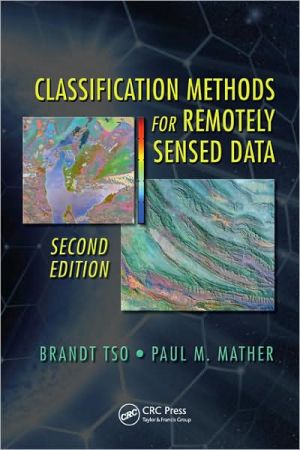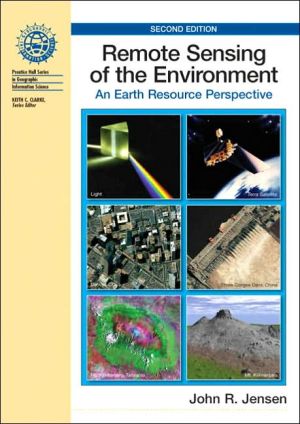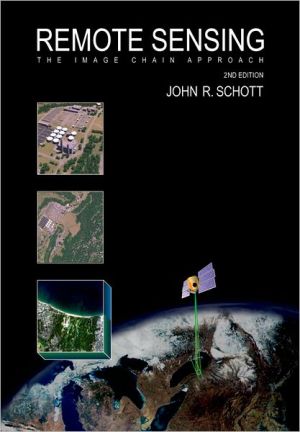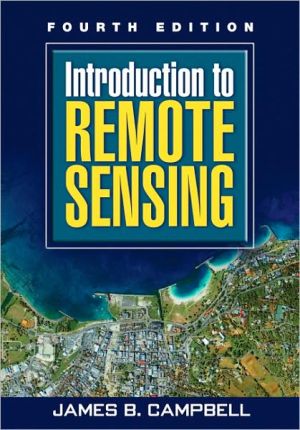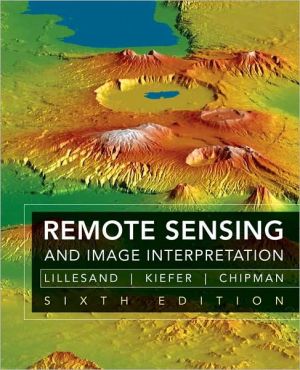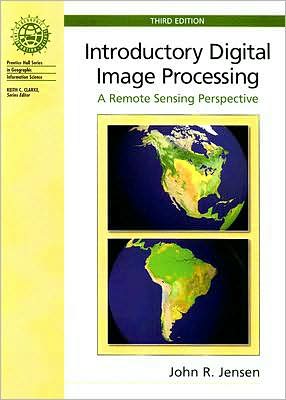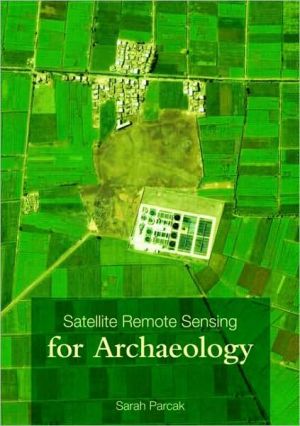Classification Methods for Remotely Sensed Data, Second Edition
Since the publishing of the first edition of Classification Methods for Remotely Sensed Data in 2001, the field of pattern recognition has expanded in many new directions that make use of new technologies to capture data and more powerful computers to mine and process it. What seemed visionary but a decade ago is now being put to use and refined in commercial applications as well as military ones.\ Keeping abreast of these new developments, Classification Methods for Remotely Sensed Data,...
Search in google:
Since the publishing of the first edition of Classification Methods for Remotely Sensed Data in 2001, the field of pattern recognition has expanded in many new directions that make use of new technologies to capture data and more powerful computers to mine and process it. What seemed visionary but a decade ago is now being put to use and refined in commercial applications as well as military ones.Keeping abreast of these new developments, Classification Methods for Remotely Sensed Data, Second Edition provides a comprehensive and up-to-date review of the entire field of classification methods applied to remotely sensed data. This second edition provides sevenfully revised chapters and two new chapters covering support vector machines (SVM) and decision trees.The book also provides updated discussions and descriptions of Earth observation missions along with updated bibliographic references. After an introduction to the basics, the text provides a detailed discussion of different approaches to image classification, including maximum likelihood, fuzzy sets, and artificial neural networks.This cutting-edge resource:Presents a number of approaches to solving the problem of allocation of data to one of several classes (Section 4.4)Covers potential approaches to the use of decision trees (Section 6.0)Describes developments such as boosting and random forest generation (section 6.8) Reviews lopping branches that do not contribute to the effectiveness of the decision trees (section 6.7)Complete with detailed comparisons, experimental results, and discussions for each classification method introduced, this book will bolster the work of researchers and developers by giving them access to new developments. It also provides students with a solid foundation in remote sensing data classification methods.
Preface to the Second Edition xiPreface to the First Edition xiiiAuthor Biographies xixChapter 1 Remote Sensing in the Optical and Microwave Regions 11.1 Introduction to Remote Sensing 41.1.1 Atmospheric Interactions 51.1.2 Surface Material Reflectance 51.1.3 Spatial and Radiometric Resolution 81.2 Optical Remote Sensing Systems 101.3 Atmospheric Correction 111.3.1 Dark Object Subtraction 121.3.2 Modeling Techniques 131.3.2.1 Modeling the Atmospheric Effect 131.3.2.2 Steps in Atmospheric Correction 171.4 Correction for Topographic Effects 191.5 Remote Sensing in the Microwave Region 221.6 Radar Fundamentals 231.6.1 SLAR Image Resolution 241.6.2 Geometric Effects on Radar Images 261.6.3 Factors Affecting Radar Backscatter 291.6.3.1 Surface Roughness 291.6.3.2 Surface Conductivity 301.6.3.3 Parameters of the Radar Equation 301.7 Imaging Radar Polarimetry 311.7.1 Radar Polarization State 321.7.2 Polarization Synthesis 341.7.3 Polarization Signatures 351.8 Radar Speckle Suppression 371.8.1 Multilook Processing 371.8.2 Filters for Speckle Suppression 38Chapter 2 Pattern Recognition Principles 412.1 Feature Space Manipulation 422.1.1 Tasseled Cap Transform 452.1.2 Principal Components Analysis 462.1.3 Minimum/Maximum Autocorrelation Factors (MAF) 502.1.4 Maximum Noise Fraction Transformation 512.2 Feature Selection 522.3 Fundamental Pattern Recognition Techniques 542.3.1 Unsupervised Methods 542.3.1.1 The k-means Algorithm 542.3.1.2 Fuzzy Clustering 562.3.2 Supervised Methods 572.3.2.1 Parallelepiped Methods 572.3.2.2 Minimum Distance Classifier 572.3.2.3 MaximumLikelihood Classifier 582.4 Combining Classifiers 612.5 Incorporation of Ancillary Information 622.5.1 Use of Texture and Context 632.5.2 Using Ancillary Multisource Data 632.6 Sampling Scheme and Sample Size 652.6.1 Sampling Scheme 662.6.2 Sample Size, Scale, and Spatial Variability 672.6.3 Adequacy of Training Data 692.7 Estimation of Classification Accuracy 692.8 Epilogue 74Chapter 3 Artificial Neural Networks 773.1 Multilayer Perceptron 773.1.1 Back-Propagation 783.1.2 Parameter Choice, Network Architecture, and Input/Output Coding 823.1.3 Decision Boundaries in Feature Space 843.1.4 Overtraining and Network Pruning 883.2 Kohonen's Self-Organizing Feature Map 903.2.1 SOM Network Construction and Training 903.2.1.1 Unsupervised Training 913.2.1.2 Supervised Training 933.2.2 Examples of Self-Organization 943.3 Counter-Propagation Networks 983.3.1 Counter-Propagation Network Training 993.3.2 Training Issues 1013.4 Hopfield Networks 1013.4.1 Hopfield Network Structure 1023.4.2 Hopfield Network Dynamics 1023.4.3 Network Convergence 1033.4.4 Issues Relating to Hopfield Networks 1053.4.5 Energy and Weight Coding: An Example 1063.5 Adaptive Resonance Theory (ART) 1083.5.1 Fundamentals of the ART Model 1093.5.2 Choice of Parameters 1123.5.3 Fuzzy ARTMAP 1133.6 Neural Networks in Remote Sensing Image Classification 1163.6.1 An Overview 1163.6.2 A Comparative Study 119Chapter 4 Support Vector Machines 1254.1 Linear Classification 1264.1.1 The Separable Case 1264.1.2 The Nonseparable Case 1294.2 Nonlinear Classification and Kernel Functions 1304.2.1 Nonlinear SVMs 1304.2.2 Kernel Functions 1324.3 Parameter Determination 1354.3.1 t-Fold Cross-Validations 1374.3.2 Bound on Leave-One-Out Error 1384.3.3 Grid Search 1404.3.4 Gradient Descent Method 1424.4 Multiclass Classification 1444.4.1 One-against-One, One-against-Others, and DAG 1444.4.2 Multiclass SVMs 1464.4.2.1 Vapnik's Approach 1464.4.2.2 Methodology of Crammer and Singer 1474.5 Feature Selection 1494.6 SVM Classification of Remotely Sensed Data 1504.7 Concluding Remarks 153Chapter 5 Methods Based on Fuzzy Set Theory 1555.1 Introduction to Fuzzy Set Theory 1555.1.1 Fuzzy Sets: Definition 1565.1.2 Fuzzy Set Operations 1575.2 Fuzzy C-Means Clustering Algorithm 1595.3 Fuzzy Maximum Likelihood Classification 1625.4 Fuzzy Rule Base 1645.4.1 Fuzzification 1655.4.2 Inference 1695.4.3 Defuzzification 1715.5 Image Classification Using Fuzzy Rules 1735.5.1 Introductory Methodology 1735.5.2 Experimental Results 178Chapter 6 Decision Trees 1836.1 Feature Selection Measures for Tree Induction 1846.1.1 Information Gain 1856.1.2 Gini Impurity Index 1886.2 ID3, C4.5, and SEE5.0 Decision Trees 1896.2.1 ID3 1896.2.2 C4.5 1936.2.3 SEE5.0 1966.3 CHAID 1976.4 CART 1986.5 QUEST 2016.5.1 Split Point Selection 2016.5.2 Attribute Selection 2036.6 Tree Induction from Artificial Neural Networks 2046.7 Pruning Decision Trees 2056.7.1 Reduced Error Pruning (REP) 2076.7.2 Pessimistic Error Pruning (PEP) 2076.7.3 Error-Based Pruning (EBP) 2086.7.4 Cost Complexity Pruning (CCP) 2096.7.5 Minimal Error Pruning (MEP) 2126.8 Boosting and Random Forest 2146.8.1 Boosting 2146.8.2 Random Forest 2156.9 Decision Trees in Remotely Sensed Data Classification 2176.10 Concluding Remarks 220Chapter 7 Texture Quantization 2217.1 Fractal Dimensions 2227.1.1 Introduction to Fractals 2237.1.2 Estimation of the Fractal Dimension 2247.1.2.1 Fractal Brownian Motion (FBM) 2257.1.2.2 Box-Counting Methods and Multifractal Dimension 2267.2 Frequency Domain Filtering 2317.2.1 Fourier Power Spectrum 2317.2.2 Wavelet Transform 2357.3 Gray-Level Co-Occurrence Matrix (GLCM) 2397.3.1 Introduction to the GLCM 2397.3.2 Texture Features Derived from the GLCM 2417.4 Multiplicative Autoregressive Random Fields 2437.4.1 MAR Model: Definition 2437.4.2 Estimation of the Parameters of the MAR Model 2457.5 The Semivariogram and Window Size Determination 2467.6 Experimental Analysis 2497.6.1 Test Image Generation 2497.6.2 Choice of Texture Features 2507.6.2.1 Multifractal Dimension 2507.6.2.2 Fourier Power Spectrum 2507.6.2.3 Wavelet Transform 2507.6.2.4 Gray-Level Co-Occurrence Matrix 2507.6.2.5 Multiplicative Autoregressive Random Field 2517.6.3 Segmentation Results 2517.6.4 Texture Measure of Remote Sensing Patterns 252Chapter 8 Modeling Context Using Markov Random Fields 2558.1 Markov Random Fields and Gibbs Random Fields 2568.1.1 Markov Random Fields 2568.1.2 Gibbs Random Fields 2578.1.3 MRF-GRF Equivalence 2598.1.4 Simplified Form of MRF 2618.1.5 Generation of Texture Patterns Using MRF 2638.2 Posterior Energy for Image Classification 2648.3 Parameter Estimation 2678.3.1 Least Squares Fit Method 2688.3.2 Results of Parameter Estimations 2718.4 MAP-MRF Classification Algorithms 2738.4.1 Iterated Conditional Modes 2748.4.2 Simulated Annealing 2758.4.3 Maximizer of Posterior Marginals 2778.5 Experimental Results 278Chapter 9 Multisource Classification 2839.1 Image Fusion 2849.1.1 Image Fusion Methods 2849.1.2 Assessment of Fused Image Quality in the Spectral Domain 2879.1.3 Performance Overview of Fusion Methods 2889.2 Multisource Classification Using the Stacked-Vector Method 2889.3 The Extension of Bayesian Classification Theory 2909.3.1 An Overview 2909.3.1.1 Feature Extraction 2919.3.1.2 Probability or Evidence Generation 2929.3.1.3 Multisource Consensus 2929.3.2 Bayesian Multisource Classification Mechanism 2929.3.3 A Refined Multisource Bayesian Model 2949.3.4 Multisource Classification Using the Markov Random Field 2959.3.5 Assumption of Intersource Independence 2969.4 Evidential Reasoning 2979.4.1 Concept Development 2979.4.2 Belief Function and Belief Interval 2999.4.3 Evidence Combination 3029.4.4 Decision Rules for Evidential Reasoning 3049.5 Dealing with Source Reliability 3049.5.1 Using Classification Accuracy 3059.5.2 Use of Class Separability 3059.5.3 Data Information Class Correspondence Matrix 3069.5.4 The Genetic Algorithm 3079.6 Experimental Results 309Bibliography 317Index 349
